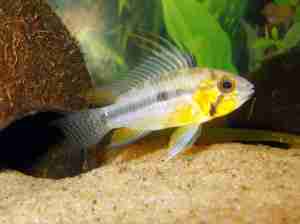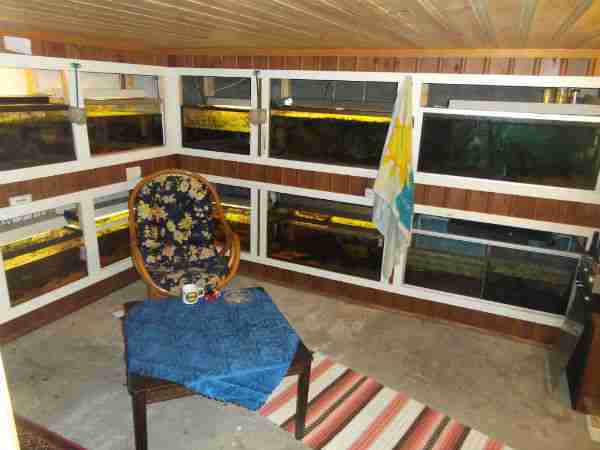
Leif ‘Apisto’ Johansen has quite a fishroom with around 30 tanks making up the collection. Among his holdings are what most would deem a very nice collection of Apistogrammas, a dwarf cichlid from South America. You wouldn’t at first think that a dedicated hobbyist living in Norway would have such a thriving interest.
“I guess its been about 10 or 12 years ago I got my first 3 apisto species. Started up with cacatuoides, macmasteri and hongsloi. All tank bred. Now I just keep wild strains. I have good access and know a collector who helps me a lot with new species”
Apistogramma are some of the first fish we started seeing being kept in biotope aquariums. Biotopes are aquariums that are set up to look like a part of natural environment. The old days of blue aquarium gravel and neon plants are hopefully largely behind us. Apistogramma need some comfort zones even though tank bred and reared are less wary and less cautious than wild caught fish. The addition of dither fish will also help greatly which are plentiful in the Amazon waters.
“I have never been to the Amazon, but I’d like to go there some time. Rio Nanay keeps a lot of nice apisto species. Also some of the surrounding areas. At the moment I keep 18 apisto species. But in the end of summer i’ll be keeping a few more. Panduro is the first ill get home”
 When most fish keepers think of dwarf cichlids, especially apistogrammas, they think of their old standby 10 gallon tank. However apistogrammas will fare better in a larger tank with more area.
When most fish keepers think of dwarf cichlids, especially apistogrammas, they think of their old standby 10 gallon tank. However apistogrammas will fare better in a larger tank with more area.
“To me a 10 gallon tanks no more use than to fry. To pairs I’ll say 85 liters (20 US gallons) is my smallest size and i use 128/160 liter (30 to 40 US gallon) for trios and smaller groups. Bigger is better mate! Even my fry tanks are bigger than 10 gallons.”
With 18 different species of apistogramma in the fishroom and growing Leif knows a little something about breeding his apistogrammas as well. Having kept as many as 35 species or locations and bred 25 or so, his experience in breeding has been built over time.
“Its almost the same with all apisto species. Only main difference is how the female acts to the male when she has fry. Some females will chase or hunt the male down and fight him, others let the male be with her.”
Some of the hundreds or thousands of fry that Leif has produced from both tank raised and wild caught fish should bring hope to new coming fish keepers. Provided the fish are kept happy with plenty of room for hiding and territory, most are able to be bred in captivity with good results.

Leif Johansen runs 3 apistogramma Facebook groups by himself and a dwarf cichlid group together with his friend from The Netherlands. He also has two community pages for apistogramma and one page that he posts his photographs on. He doesn’t run a website for his apistogramma.
You can find the groups and pages that Leif runs at the web addresses below. Be sure to check them out
Norwegian Apistogramma Forum
https://www.facebook.com/groups/506115422744869/
If you are interested in trading apistogrammas and you are local check out the Norwegian Apistogramma Trading Forum
https://www.facebook.com/groups/640132422717564/
And another local site Vi Med Apistogramma I Skandinavia
https://www.facebook.com/groups/218255701684658/
The International Dwarf Cichlid Forum
https://www.facebook.com/groups/theinternationaldwarfcichlidforum/
Apistogramma Planet
https://www.facebook.com/pages/Apistogramma-Planet/1427583667492403
Leif Apisto Johansen Apistogramma Profiles
https://www.facebook.com/pages/Leif-Apisto-Johansens-apistogramma-profiles/305994979559130
Here you can find some of Leifs apistogramma pictures.
https://www.facebook.com/pages/Leifs-photos/305385682952856
Photos courtesy of Leif Johansen
Written by: S F Shinola.
 Biotope One A Study of Flora and Fauna
Biotope One A Study of Flora and Fauna 


